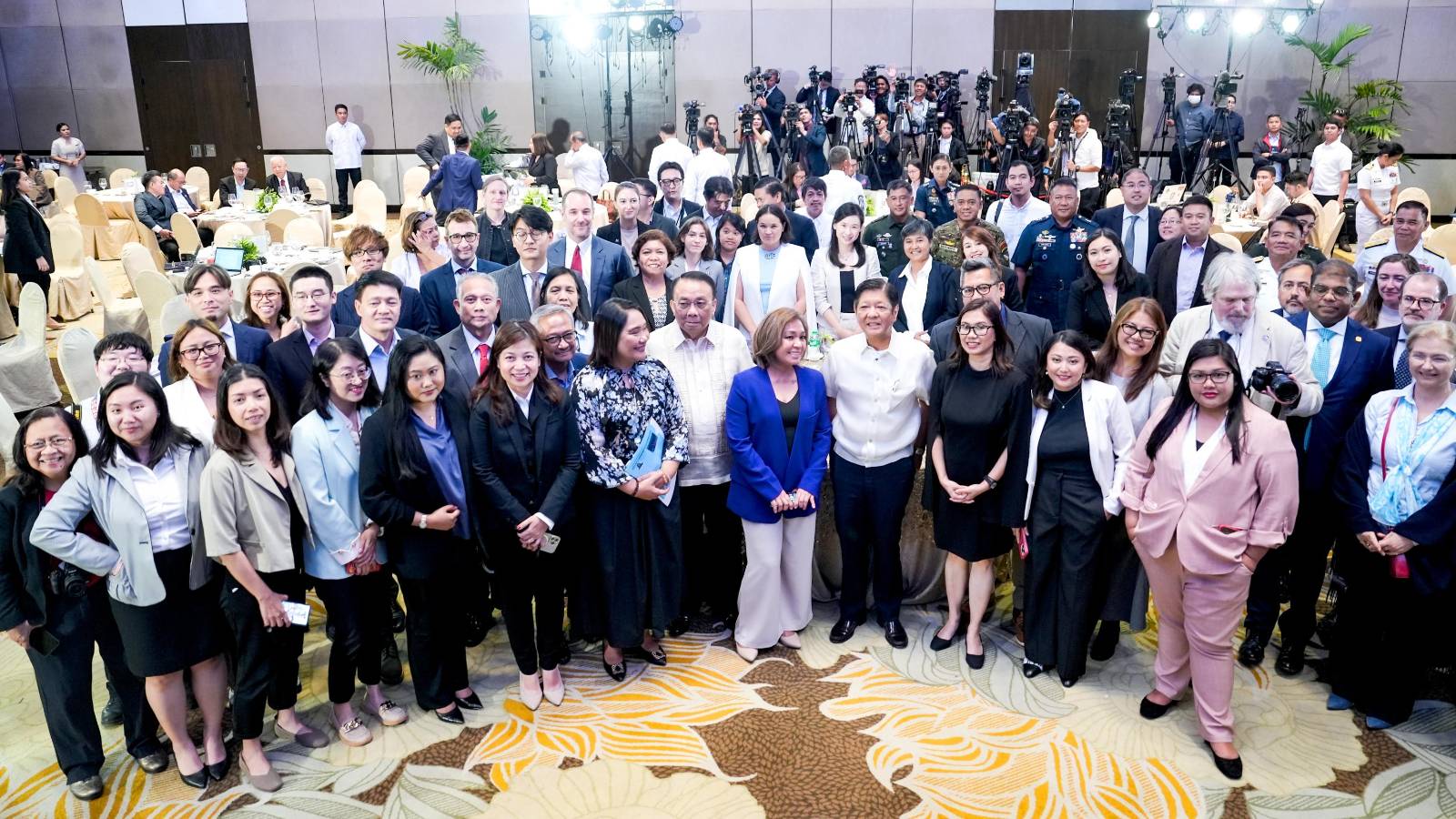January 11, 2017 -Press Briefing by Presidential Spokesperson Ernesto Abella and NEDA Director-General Ernesto Pernia and Commission on Population Executive Director Juan Antonio Perez III
| Press Briefing by Presidential Spokesperson Ernesto Abella and NEDA Director-General Ernesto Pernia and Commission on Population Executive Director Juan Antonio Perez III |
| Press Briefing Room, New Executive Building, Malacañang |
| 11 January 2017 |
| OPENING STATEMENT:
PRESIDENTIAL SPOKESPERSON ABELLA: Good afternoon. We are holding a special press briefing this afternoon especially for a report coming from NEDA director Ernesto Pernia. Secretary Pernia is no stranger to us here. Today, he will talk about the 10-point socio-economic agenda of the Duterte administration, especially regarding Responsible Parenthood and Reproductive Health Law. Ladies and gentlemen of the Malacañang Press Corps, let us all give a warm welcome to one of the President’s economic managers, Socioeconomic Planning Secretary and Director General of the National Economic and Development Authority, Dr. Ernesto Pernia. SEC. PERNIA: Good afternoon, Secretary and thank you Secretary Abella. Good afternoon to all of you and a Happy New Year and I’d like to wish you salud, amor, felicidad y dinero en el año nuevo. That is health, love, happiness and money in the New Year, more money, okay. So I hope that will open to all of us. I am with the director — executive director of the Population Commission, Commission on Population, Dr. JP Perez. He’s here and as you know, POPCOM is an agency that’s involved in not only advocacy but also in helping implement the responsible parenthood and reproductive health law of the government. And the reason why we thought that we should have this press conference is something very important has happened and that is the signing by the President of the Executive Order which is, which has to do with ensuring that we are able to meet zero unmet need for family planning. Meaning that all women of reproductive ages should be able to achieve their desired family size, their desired number of children rather than having more children than they want or they can afford and provide for adequately and that is exactly the essence of the RP, reproductive — Responsible Parenthood and Reproductive Health Law — RPRH Law for short. And the reason why this is a very important development is that the RPRH Law… Important provisions of the RPRH law has been stymied by the issuance of a TRO by the Supreme Court and the TRO was issued on the petition of so-called pro-life groups. Pro-life groups meaning that they’re really conservative groups. They keep saying that contraception or family planning or the reproductive health law is abortifacient, it’s anti-life. But, of course, we in the government, we think differently, just the opposite. We feel that it is pro-life, pro-women, pro-children, and pro-economic development. So the link between family planning or the implementation of the RPRH law is critical — the link between family planning and economic development, socio-economic development is quite intimate so… And if we don’t implement the RPRH law fully, which was declared by the President during the SONA, then we are going to be unable to meet our poverty reduction target from 22 percent now, 21.6 percent to be exact as of 2015, we want to bring that down to 14 or even 13 percent by the end of the Duterte administration. I’ll explain to you why the link is so critical and why there’s a need to fully implement the RPRH Law. So the EO was just signed the other day. It’s Executive Order No. 12 and the full title of the EO is Attaining and Sustaining Zero and Met Need for Modern Family Planning Services through the Strict Implementation of the Responsible Parenthood and Reproductive Health Act, Providing Funds Therefore and for Other Purposes. It took about 3 months for us to get this signed so we feel very delighted that it has finally been signed and the reason is that they — you know, when — EOs have to undergo very close scrutiny by the legal department of Malacañang so that nothing is left, nothing doubtful or nothing controversial or nothing unconstitutional is in the EO. So I’d like Dr. Perez to also, you know, participate in this press conference. So I’ll just start it and then I’ll ask him to say his piece because he is the one really on the ground in terms of implementation. POPCOM is co-chaired by NEDA and the Department of Health. Secretary Ubial wanted to be here but she has this engagement in Baguio and maybe some other time, we will also talk, we will have a conversation with the press in terms of actual implementation because they are the ones who deliver the service. Okay? That is the… Any questions? QUESTIONS & ANSWERS: JP Bencito (The Manila Standard): Sir, good afternoon. Sir, in terms of the coverage and scope of the EO, ano po ‘yung magiging — ma-a-access ng kababayan natin in terms of RH or reproductive, responsible parenthood methods? Ano po ‘yung mga pwedeng ma-avail na services? SEC. PERNIA: Well, the EO is really for modern family planning services, modern contraceptives to be adopted by women of reproductive age. As I’ve said, in order for them to make — in order for them to achieve their desired number of children. And this is, this also requires adequate budget, budgetary support from the government. Because this is going to be a free — this will be at no cost to the users of the — or the acceptors of contraceptives. Mr. Bencito: Sir, when do we expect this — with the signing of the EO, sir, when do we expect this to reach the ground, sir, ‘yung mga services na you’ve mentioned earlier? SEC. PERNIA: Well, you know the RPRH Law was approved by Congress on December 12 — I think it was December 12 or 20? Something like — 2012. So that was about what? Four years ago. Then it got stymied because again — well, not again but to begin with, the so-called pro-life groups submitted a petition to the Supreme Court that it is anti-life, it is pro-abortion so… And then the — okay. So they…As soon as the law was passed then they submitted this petition to the Supreme Court and the Supreme Court issued a TRO or a status quo ante on the RPRH Law and so that’s 2012. And it took more than a year or one year and two months for the Supreme Court to decide on April 2013, 2014 na ba? 2014, that the RPRH Law is not unconstitutional. Although, there were certain provisions that stricken out by the Supreme Court. But in essence, the decision of the Supreme Court was that the RPRH Law is not unconstitutional. So that’s why, you know, starting on April 2014, we were supposed to…I mean the government should already have implemented the law in full. But then 2015, June, June 2015 was another petition submitted by the pro-life groups, so-called pro-life groups and the TRO was imposed by the Supreme Court. So until now, the TRO is still there. But with this EO from the President, we hope that the Supreme Court will act expeditiously in terms of lifting the TRO. In fact, with the EO, some, you know, there might be some municipalities or local governments that can, you know, get around the TRO by letting NGOs implement or, you know, yeah implement the RPRH Law because the private sector is not covered by the TRO. It’s just the government agencies. So, in fact, there are some implementation of the RPRH Law but it’s very limited. Pia Ranada (Rappler): Secretary, given the standing TRO, what are exactly the ways by which the government or agencies can go around as you say the TRO and isn’t this running counter to the separation of Church and State when you have the Executive branch issuing an order that the Supreme Court has already said, you know, they have given another order contrasting to this EO. Isn’t this sort of a challenge to the SC decision on the law? SEC. PERNIA: Well, it is a — it is not…Well, it’s just telling the public including the Supreme Court that we cannot…We cannot stand…The government cannot continue to tolerate this delay in judgment because time is of the essence as far as the implementation of the RPRH Law is concerned. Everyday about 11 women die from complications of pregnancy and delivery. The maternal mortality rate of — in the Philippines is still pretty high about 221, 221 — 231 maternal deaths per 100,000 live births which is the target as far as the Millennium Development Goals are supposed to be 50 ano? 52. So but we have not been able to do that because of this, you know — because we haven’t had family planning implemented for a long time already. Implemented by the…We haven’t had a family planning program funded by the government. So the RPRH Law is not just to enable families to achieve their desired number of children but also to prevent or to lower maternal mortality rates as well as teenage pregnancies. As you know, teenage pregnancies have been rising. In other countries, teenage pregnancies are diminishing but in the Philippines, it’s rising. So there are many objectives that can be achieved by implementing the RPRH law having to do with life: life of the mother, health of the mother, the health of teenagers as well as you know, births that are wanted. You know, you don’t want women to be having unwanted pregnancies because then, they would have difficulty raising their babies to their full potential. Celerina Monte (Manila Shimbun): Good afternoon, sir. So, sir, until such time that the TRO is lifted, the government could not implement that EO, right? SEC. PERNIA: Yes. One method of family planning is under TRO and that is the subdermal implants, implanon. And the thing about implanon, it is the most cost-effective contraceptive because it is good for three years and it’s relatively inexpensive. If you compare the… If you reckon the fact that it is effective for three years and it’s just a once-off cost in the initial — you know, when it’s implanted, then it’s really the most effective. And, you know, women don’t have to be conscious. They don’t have to keep tab of their, you know, of their fecundity, period of fecundity. Ms. Monte: So, sir, how about ‘yung condom, ‘di ba this is part of the TRO yata rin? SEC. PERNIA: No. Condoms and pills are covered to the extent that, yeah, the Supreme Court… If the Supreme Court doesn’t lift this TRO, then the supplies — yeah, the authority of FDA as well as those who can import pills and condoms and IUDs will not be able — will gradually expire. Okay, maybe I will ask Dr. Perez to also give an introductory statement before we have a full discussion in the open forum. EXECUTIVE DIRECTOR PEREZ: Thank you, Sec. Pernia. The Executive Order as issued by the President was reviewed thoroughly by the legal department, by the different agencies that will implement it and it will not be contrary to the TRO of the Supreme Court. The TRO of the Supreme Court only covers the use of subdermal implant, as mentioned by Secretary Pernia. The other contraceptives are affected — will be affected over time if the Supreme Court does not lift the TRO because contraceptives have a license to be marketed that is issued by the FDA. Now over time, over the next three to four years, those licenses will expire. Unless the Supreme Court lifts the TRO, the government will be left with methods like tubal ligation, vasectomy and the natural family planning methods. So the modern methods, which we call “artificial methods” might have problems. Now, right now we are still able to use all the methods and the President is calling on the three major agencies: DOH, DILG and POPCOM to assist local governments in implementing this Responsible Parenthood Reproductive Health Law by mapping out and identifying the women who have a need for family planning. So there is a plan to, in the next six months for local governments to go out in the field, to do house-to-house visits, identify those in need of family planning, working with all these agencies. And probably over the next two years, the President is asking the agencies to support at least the two million women in the poorest sector so that they can get family planning services and over the rest of the administration to reach at least six million women. These are the women who have unmet need for family planning. And which I why it is urgent that this Executive Order be implemented as soon as possible because is really a tall order to reach six million over the next six years of this administration. And if we are able to do that as Secretary Pernia was saying, we will be able to achieve — we will be able to approach the contraceptive prevalence rate of 65 percent, that means 65 percent of women using family planning. Right now, it’s still around 40 percent. So that is the gap we must address to this executive order and hopefully the executive order will be heeded by local governments, by civil society will support it, and all the major agencies of governments will be mobilized through this Executive Order. Ms. Monte: Sir, do you see any worst-case scenario just in case the Supreme Court continues with that TRO kasi you are saying that the permits would expired? EXECUTIVE DIRECTOR PEREZ: Yes, last year because the TRO has been in place for one and a half years, since June as the Secretary mentioned. So 15 contraceptives have been left out of the market officially by—because there are CPRs or Certificates of Product Registration expired. This year another 15 will expire. So by 2018, there will be only one or two contraceptives left in the market, unless the Supreme Court lifts the TRO. So we…The Secretary of Health through the Office of Solicitor General filed a motion for reconsideration last October. And because of this motion for reconsideration, the decision is now… We are now awaiting for the final decision on the Supreme Court — of the Supreme Court whether they will ask government to really re-certify all the contraceptives. So right now, we are still able to implement the entire program except for the one method while there is a motion for reconsideration. Ms. Monte: Sir, last question, how much is the budget allotted for this particular—in the implementation of this EO? And does the 2017 budget already include this budget in this year? EXECUTIVE DIRECTOR PEREZ: The Department of Health submitted a budget of over 200 million for contraceptives to Congress. And I believe they got an increase up to 600 million but probably DOH can verify that. Of course, the entire budget of the Commission on Population is focused on population development. And 60 percent of our field budget will be focused on implementing the RPRH Law. We have a budget around 400 million. So and I guess—other agencies like the Department of Education are implementing the Comprehensive Sexuality Education, DSWD is supporting the program as well. Commission on Women, National Youth Commission, and these are other agencies that are contributing. Tina Mendez (Philippines Star): Good afternoon, sir. Please correct me if I’m wrong that our population, ang annual increase is 2 million a year? EXECUTIVE DIRECTOR PEREZ: Based on the projections of the Philippine Statistical Authority our population this year will increase by 1.6 million. Ms. Mendez: Sir, if this EO is fully implemented, how will it impact ‘yung population growth natin? How will it slow down the population rate? EXECUTIVE DIRECTOR PEREZ: Well over time…I think right now the population growth rate is around 1.7 because we have a hundred million, over a hundred million, 104 million population right now that results to around 1.6 million added every year. If this program is fully implemented by up to 2022, we predict that the population growth rate might go down to around 1.4, but that’s a projection. And that means 65% of women using family planning methods. The 65% of women are women who actually want family planning but are not able to practice it. So we do not even need to convince women, we do not need to force anyone to have family planning because they all want. At least two-thirds of women of reproductive age who are married want family planning. Henry Uri (DZRH): Sir and Secretary last June the President says that he is up for a three-child policy ano ho. May binabanggit siya na “three is enough”, sabi niyang ganon. Hanggang ngayon ho ba ‘yon pa rin ang posisyon ng ating Pangulo at napag- uusapan ho ba ito sa Cabinet meeting? SEC. PERNIA: Well, a specific number of children cannot be legislated. What the President was saying was to urge or to encourage families not to have more children than they can afford to take care of and provide for. Such that a children would really be able to achieve their full potential. They get adequate health care, they get adequate education, and they will be better off than their poor parents when they are grown up. So that’s really… The logic is — it’s really… You know, in Economics, we always talks about trade off. The family planning program will be able to make parents trade off, will be able to make parents trade off quantity for quality. In other words, instead of having many children, I think it’s better for us to have the number of children that we can afford to support in terms of education, health care and other needs of the youth. Mr. Uri: So it was just a suggestion of the President? SEC. PERNIA: It was a suggestion. Mr. Uri: Not authoritatively he is telling everyone? SEC. PERNIA: Yes, he has been saying that even before, I think even during the campaign he had said, he had mentioned that in Davao, we have an effective family planning program and my encouragement to the parents was not to go beyond three children especially — depending, of course, on the means of the parents. If you have…If you are…If you can afford five children, you have the choice to do that. If you have the means to support them. So it’s not going to be definitely it’s not likely to be a law or a mandate or an EO not even an EO from the President. Mr. Uri: Pero kung kayo po ang tatanungin sa gobyernong kasalukuyan, so ipinapayo ninyo na hanggang tatlo lamang dapat maging anak ng isang mag-asawa? SEC. PERNIA: Hindi na papayagan…No, you allow then or you encourage them by providing the means to plan their families to have three children. In fact, that data would show that the poorest quintile, the poorest 20% of households have actually five children or a little over five children on average. But they say that they want only three. So if we are able to avert the two so-called “unwanted births”, then not only will population growth be slowed — slowed dow. The fewer children that poor families bring in to this world can be better educated, better — can be given health care and when they grow up, they will be productive citizens and probably in terms… Instead of the vicious cycle of poverty, parents having children who will grow — who will grow to be poor parents when they become parents. So instead of that, the children of poor parents will be better off when they grow up. Mr. Uri: Sir, lastly, magkano na ho ang per capita income ng isang pamilya ngayon? SEC. PERNIA: Per capita income in terms of US dollars, because we use US dollar because we can compare it with other countries, it’s about 3,700 I think dollars, as of now. But that’s a very — that’s a gross average because, you know, as you know income inequality is pretty high. So there’s income is unequally distributed across families. AC Nichols (CNN Philippines): Hi, sir, good afternoon. Sir, just to clarify what the EO primarily will do is it will allow for LGUs and other concerned agencies to be mobilized and to map out or reach out to women who do not have access to family planning. But in terms of ‘yung doon sa grant of certification or recertification of contraceptives which is being stopped by the TRO, the EO will not have anything to do with that? SEC. PERNIA: No, the EO will…You know, the EO will not have an immediate effect on the certification because the certification is still valid for another year or so. But after that, then if the TRO is not lifted, then those who can import contraceptives will be prevented from importing such that women would be limited to so-called family planning — natural family planning program which is very ineffective or unreliable, as you know. Ms. Nichols: So when that happens, what can the EO do when that happens when the contraceptives are not coming in anymore? I mean what’s the main point of the EO? SEC. PERNIA: Well, the point of the EO is really to allow a wider implementation of the RPRH law not necessarily by government agencies but by NGOs and people’s organizations. And there’s a way of, you know…There are donors that can help provide contraceptive supplies that may not be implementable by the government agencies but can be implemented by private sector agencies. Ms. Nichols: But will the EO be able to go around the TRO? SEC. PERNIA: Well, it depends on the creativity of local government executives. If they are imaginative and creative, they can find ways of implementing the RPRH Law despite the TRO. And, well, the other thing that the TRO will achieve will be to motivate, to urge, to even pressure the Supreme Court to, you know, to stop dilly-dallying on this TRO. A year and a half is too long a wait. I don’t know why the, you know, the Supreme Court cannot act more swiftly. I mean it is a wonder. A simple matter and, in fact, it has already been declared not unconstitutional and yet you listen to this small minority, small noisy minority. So it’s really a tyranny of the minority what’s happening here. This small noisy minority is being listened to vis-à-vis the majority who want the RPRH law. I mean the surveys have shown up. Pulse Asia, SWS, 70 to 80% of adult Filipinos want family planning. They want the RPRH Law. Let me just… Dr. Perez was referring to contraceptive prevalence rate which is in the Philippines is only about 40-45%. In Thailand or in Bangladesh, the contraceptive prevalence rate, meaning the percentage of women practicing modern family planning methods, they reach up to 75%. So we really need to wrap up our contraceptive prevalence rate to around 70%, 65 at least, better 70% in order to achieve zero unmet need for family planning. In order to enable women to have the number of children that they can afford and they want. And, you know, if we just make a back of the envelope calculations, there are so many million women having more children that they want. And they are having at least two children in excess of what they want. If you, you know, if you assume that these two unwanted births per woman are taken away, are averted, then naturally poverty will go down. Because, you know, poverty incidence is just a number of poor households or poor population over, you know, the population. So that’s the pure demographic effect. But the thing about the…It’s not just the pure demographic effect that we can expect. There’s also an economic demographic dynamic that will happen. Meaning that when women who are able to avert their unwanted pregnancies, then they can be — they can participate in training programs, continuing education so that they become more employable. And when they join the labor market, when they are employed, then that becomes even a stronger motivation to have fewer children. To have even fewer than what they want. Okay? And so that is the economic demographic dynamic that can work and will push down poverty and inequality even further. There’s one question there. Let her… We put a lot of importance to this thing that’s why you know, that’s why we are accommodating your questions. Vans Fernandez (DZRJ): Sir, but there are religious groups that are against controlling children. What can you say? SEC. PERNIA: What’s this? Ms. Fernandez: Some religious groups. SEC. PERNIA: Ah religious groups, precisely, yeah. Ms. Fernandez: Yes, are not in favor of this RPRH Law and which groups participated in this RPRH Law? SEC. PERNIA: Yeah. Well, let them have their, you know… Let them do what their belief tells them. But, you know, but don’t let them — don’t let the few dominate the many. That’s really just the…It’s a simple, you know, way of… It’s really a democratic way. Who are you going to listen to? The government should follow the majority more than the minority. And it’s really a small group. |































